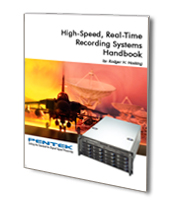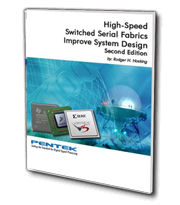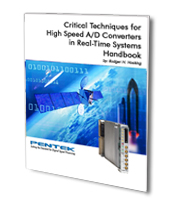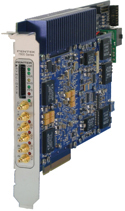
Sign-Up for Flexor FMC Updates!


Sign-Up for Talon System Updates!


Sign-Up for Onyx Virtex-7 Updates!


Sign-Up for Cobalt Virtex-6 Updates!


Sign-Up for the Pipeline Newsletter!

Free Technical Resources:

High-Speed, Real-Time
Recording Systems Handbook


High-Speed Switched Serial
Fabrics Improve System Design


Software Defined Radio
Handbook


Putting FPGAs to Work for
Software Radio Handbook


Critical Techniques for High
Speed A/D Converters in
Real-Time Systems Handbook

Pentek Literature:


| |
To simulate a modern, frame-based radar, a system needs to rapidly create or schedule signals that are fundamentally complex in nature and can vary considerably over time based on mission, mode, and environmental considerations.
Multiple Pulse Repetition Intervals (PRIs), different types of Modulation on Pulse (MOP), as well as rapid changes in amplitude and frequency (which include the effects of Doppler, group delay, and clutter) need to be taken into account and combined with multi-mission operations such as communications, electronic attack, or counter measures scheduling.
|
"This article explores a fully modular system that is highly reconfigurable and can be used to create emitters, not only for testing purposes, but versatile enough for rapid prototyping or for meeting the needs of fastcycle technology procurements."
Mark Elo, Vice President of Marketing, Giga-tronics, Incorporated
| |

|
Product Focus
3-Channel 200 MHz A/D and 2-Channel 800 MHz D/A with Virtex-6 FPGA - PCIe
|
Features
- Complete radar and software radio interface solution
- Supports Xilinx Virtex-6 LXT and SXT FPGAs
- Three 200 MHz 16-bit A/Ds
- One digital upconverter
- Two 800 MHz 16-bit D/As
- Up to 2 GB of DDR3 SDRAM or 32 MB of QDRII+ SRAM
- Sample clock synchronization to an external system reference
- LVPECL clock/sync bus for multiboard synchronization
- PCI Express (Gen. 1 & 2) interface up to x8 wide
| |
Model 78620


|
Product Focus
250 MS/sec RF/IF Rugged Rackmount Recorder
Q&A with Pentek
Q: What is the difference between the RTV, RTS, RTR, and RTX series of recorders?
|
A: The RTV series is the value series of Talon recorders. These are the least expensive Talon recorders and are intended for laboratory use. They are limited in storage and streaming data rates to disk and have very few options available.
| |

| |
In addition to their low cost, they also have the advantage of shipping from stock, unlike the other series that typically have lead times from six to eight weeks. These recorders come in a rackmountable PC server chassis.
|

| |
The RTS series is the commercial series of Talon recorders. These are intended for benign environments, have great flexibility in channel count and are capable of holding large volumes of data storage.
| |
These systems use HDDs (hard disk drives) for data storage and are limited in their sustained data rate to disk. These recorders come in a rackmountable PC server chassis.
|
|
The RTR series is the rugged series of Talon recorders. RTR recorders come in both a portable (briefcase style) and rackmountable PC server chassis form factor. Both use SSDs (solid state drives) to help the systems tolerate shock and vibration.
| |

| |
They also include enhanced cooling to allow them to operate in higher-temperature environments (up to 55 deg C.) The RTR series recorders provide the highest streaming data rates to disk of all of the Talon series.
|

| |
The RTX series is the extreme rugged series of Talon recorders. RTX recorders are flight certified, capable of handling high levels of shock and vibration as well as high altitude use.
| |
RTX series chassis use Pentek's QuickPac® drive packaging technology that provides the ability to quickly remove and replace 8 data storage SSDs from the Talon recorder. This is especially useful during flight missions where aircraft time is expensive.
The RTX series chassis comes in two different form factors. A rackmountable chassis uses high-powered fans to air cool system components. This chassis includes a shock-isolated inner chassis, EMI filters, and a modular rear panel to allow for customized signal connectors.
The alternate style RTX chassis focuses on SWaP and is available in a 1/2 ATR style chassis.This conduction-cooled chassis is extremely rugged and is able to operate in the harshest of environments. This chassis uses QuickPac drive packaging technology to provide up to 7.6 TB of storage in a very small package.
|
The Talon Product Comparison Chart, Analog Signal Recorder Selector and Digital Signal Recorder Selector provide an excellent starting point to help narrow down the appropriate Talon Recording System for your application.
|











